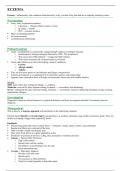ECZEMA
Eczema = inflammatory skin condition characterised by a dry, cracked, itchy rash that has a relapsing-remitting course.
-----------------------------------------------------------------------------------------------------------------------------------------------------
Presentation
Scaly, itchy, erythematous patches
o Caucasian flexures (elbows, knees, wrists)
o In infants cheeks
o POC extensor surfaces
Hypo or hyperpigmentation
Excoriation marks
Lichenification (thickening)
-----------------------------------------------------------------------------------------------------------------------------------------------------
Pathophysiology
Atopy = predisposition to abnormally exaggerated IgE response to allergen exposure
o Sensitisation to allergens/antigens detected by CD4+ Th2 lymphocyte
o This causes their differentiation exaggerated IgE response
o This causes increased risk of hypersensitivity reactions
Atopic individuals are at risk of developing a triad of conditions:
o Eczema
o Allergic rhinitis
o Asthma
They are also more prone to food allergies and allergic conjunctivitis
Eczema development is a combination of environment, genetics and immunology
Appears more common in those with high socioeconomic classes and with smaller families
Severity
Mild: areas of dry skin, infrequent itching, +/- erythema
Moderate: areas of dry skin, frequent itching, erythema, +/- excoriation, skin thickening
Severe: widespread dry skin, incessant itching, erythema, +/- excoriation, extensive thickening, bleeding, oozing, cracking,
pigmentation changes.
-----------------------------------------------------------------------------------------------------------------------------------------------------
Investigation
Diagnosis is based on clinical features in a typical distribution, and form investigation shouldn’t be routinely done for
diagnosis.
-----------------------------------------------------------------------------------------------------------------------------------------------------
Management
This is done by a stepwise approach with emollients as the underlying treatment.
Patients should identify and avoid triggers causing flares e.g. perfume, detergent, soap, clothes, hormones, foods. They can
do this by keeping a trigger diary (especially food).
Emollients
Moisturising agents that come in many forms ointments, creams, sprays, lotions, soap substitutes
Regular and liberal use is advised all the time
Help to soothe, smooth and hydrate skin
Have short lived effects so regular application is key
Emollients used alone do not have a drug, they are purely to moisturise the skin
Lotions Dermol 500, E45 lotion
o High water content
o Spread easily and are cooling
o Not effective at moisturising very dry skin
o Quick absorption time
Creams Diprobase, Epaderm
o Mixture of fat and water
o Spread easily
o Not as greasy so often preferred
o Need to be used frequently to help skin repair




